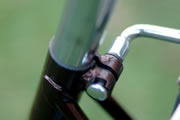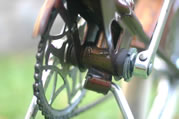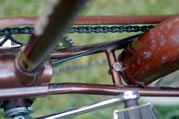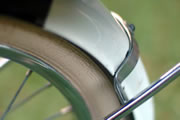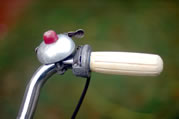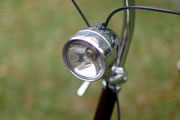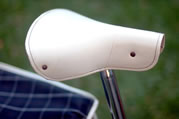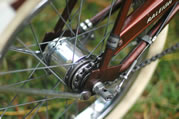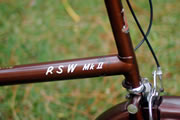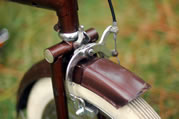A ramble on the Raleigh RSW
Raleigh's answer to the Moulton
Welcome to the Raleigh RSW, one of the iconic bikes of the swinging 60s, and the world's most sophisticated his and hers bike. I'm sure you'd agree that only something rather special would merit such a claim, but before seeing if the RSW lives up to it, let's consider its unlikely origins.
It was in the early 1960s, with the UK cycle market seemingly in terminal decline, that Raleigh was practically the last man standing of the once-proud UK cycling industry. A conservative company at the best of times, Raleigh was by then primarily interested in seeking ways to cut costs to secure its survival. It was not interested in taking risks,  and it certainly had no plans to make a strange, small-wheeled machine such as the RSW. After all, it had had the opportunity to make Alex Moulton's fully suspended small-wheeler, but knocked
and it certainly had no plans to make a strange, small-wheeled machine such as the RSW. After all, it had had the opportunity to make Alex Moulton's fully suspended small-wheeler, but knocked  it back because such a wacky idea would never sell.
it back because such a wacky idea would never sell.
But it did. And when that happened Raleigh was left red-faced and without anything with which to compete. So the designers went to work. They could come up with a Moultonesque open frame sure enough, but what they couldn't do was copy the Moulton's suspension, which compensated for the bumpy ride that comes with small wheels. Instead they gave the RSW soft, fat tyres to smooth the ride. However, those tyres not only smoothed the ride but increased the rolling resistance as well, making the bike less efficient (i.e. harder to pedal). Those tyres, along with the bike's generous avoirdupois, have been central 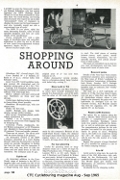 to the RSW's non-sporting reputation ever since.
to the RSW's non-sporting reputation ever since.
It was not until mid-1965 that the RSW was introduced, by which time Moulton had had over two years head start. But the picnic was over for Moulton and they were soon in financial distress. Raleigh bought them out and found itself in the novel position of making both the original small wheeler and its own copycat version. This state of affairs persisted until Raleigh canned both bikes in 1974, by which time Raleigh was profiting from the enormous success of the 'Chopper' kids bike. Raleigh was no doubt happy to rely on the RSW's more successful big brother, the 'Twenty', to serve the by-then shrinking market for adult small wheelers.
Share some fat-tyre love
The RSW 16 may have been simpler and cheaper than the Moulton, but it was still a radical design for its time. The frame was based on a large-diameter sloping downtube, with one end pressed to encircle the steer tube and the other meeting the squat rear triangle and bottom bracket under a folded pressing. It was all very solid, and it must have been, as it formed the basis of a moped version as well. (And for a few years they even made a folding version to compete with the Moulton Stowaway.) The single-piece combined swan neck stem/handlebar assembly was rather neat and effective, and it helped lighten the appearance of the chunky little beast. The low-mounted solid steel luggage rack incorporates a spring-loaded catch that allows the ginormous wooden-framed shopper bag to be easily removed.
Of particular interest are those bump-absorbing, momentum-absorbing, white tyres. I imagine Raleigh assumed potential RSW buyers would see the benefit of soft tyres  without being overly conscious of the extra rolling resistance. And in white they become a selling feature, highlighting the comfy ride while adding a touch of bling. Whatever, they're certainly distinctive and I think a defining characteristic of the bike.
without being overly conscious of the extra rolling resistance. And in white they become a selling feature, highlighting the comfy ride while adding a touch of bling. Whatever, they're certainly distinctive and I think a defining characteristic of the bike.
Needing new tyres for this RSW, I considered Raleigh-branded 'redlines' (made for the Raleigh Chopper front wheel) and Schwalbe Big Apples. I chose the Big Apples, thinking their ugliness would be more than offset by the vastly superior mix of ride comfort and rolling resistance one would expect of an extra 40 years of development. But I was wrong. Of course, the original white tyres are the best – both functionally and aesthetically – and that's what this RSW is wearing now. If you love your RSW, try to get a pair of NOS originals – it's worth it. (They were made by Dunlop and Michelin, and there are Raleigh-branded ones as well.)
This example
This RSW is the updated version, the Mark II, with  a different type of rear brake and various small changes such as flattened mudguard crowns. This particular Mark II has survived better than most; it bears the myriad scratches and bumps of honest wear and tear, but few signs of the neglect that usually afflicts bikes that outlast their
a different type of rear brake and various small changes such as flattened mudguard crowns. This particular Mark II has survived better than most; it bears the myriad scratches and bumps of honest wear and tear, but few signs of the neglect that usually afflicts bikes that outlast their  desirability.
desirability.
The most concerning cosmetic damage is the loss of some paint resulting from the long-ago application of adhesive tape. There have been no significant changes, so it remains in largely original condition. According to the writing on the cover of the owner's manual, this (three speed) bike originally cost $93.50 (Australian dollars). The coaster brake model (i.e. single speed) was $85.50.
Being a 'colonial' model (Australia), this bike has a Sturmey Archer TCW III three speed rear hub, with coaster brake, instead of the S3B with mini drum brake that lived on most home market Mk IIs. I like the TCW and think it's perfectly ok, but some people are very critical of it and think it's unsafe.
A quality product?
The RSW is so consistently derided as a slow, heavy, crude knockoff of the Moulton that it can be hard to imagine anyone at the time dishing out for it instead of the real thing. Those of us who are too young to remember can only surmise that in those days – in a world solely accustomed to big-wheelers – it was enough for the RSW to have the looks and practicality of a Moulton. And, being a Raleigh, it would have peered through the window of just about every high street bike shop.
The Raleigh brand also promised dependable service, and in that regard the RSW did not disappoint. RSWs were well made and finished; they didn't break in half, and they didn't have suspension that played up (albeit with the liberal application of mineral oil to the rubber parts!) or swing arms that fractured.
The bad bit is that they were subjected to some merciless cost cutting, such as having spoke nipples made of steel instead of brass, pressed fork ends instead of proper dropouts, and mudguard stays held on by the axle nuts instead of separate screw holes. This sort of thing may be annoying, but I do think they should have at least stretched to some ball bearings in the pedals. Hard times indeed! Like others, I used to believe that the plastic bushing used instead of upper headset bearings was cost cutting but now (red face, shame) understand that it is that way to accommodate the hand tightening of the handlebar stem.
A bike with image issues
And we love to blame the RSW for the demise of the Moulton and small wheelers in general. The holy creed is that the slow-rolling inefficiency of the RSW gave small wheelers a bad name, driving the waverers back into the big wheeler fold. My own theory is that this is only half true. It drove them back alright, but for more reasons than that. This follows from the design and marketing of the RSW, and how it differed from the Moulton.
The Moulton was designed and marketed as an improved version of the conventional bike. Alex Moulton knew potential customers would be suspicious of a bike with such small wheels, and he took pains to ensure it was accepted as the real thing. His bike was big, and various records proved it performed at least as well as conventional bikes.
In contrast Raleigh, maybe  concerned its squat little pretender couldn't compete directly with the Moulton, went for a very different buyer. They pitched it as 'a convenient adjunct to modern living', for 'the trend-setting, car-owning class of people', who require an up-to-date 'personalised form of transport to displace the motor car for local transport'. I think that means Raleigh were appealing to those who would otherwise consider cycling a bit infra dig. Suggesting a tilt towards women, they made the RSW a size or two smaller than
concerned its squat little pretender couldn't compete directly with the Moulton, went for a very different buyer. They pitched it as 'a convenient adjunct to modern living', for 'the trend-setting, car-owning class of people', who require an up-to-date 'personalised form of transport to displace the motor car for local transport'. I think that means Raleigh were appealing to those who would otherwise consider cycling a bit infra dig. Suggesting a tilt towards women, they made the RSW a size or two smaller than  the Moulton and emphasised its smooth ride, smart appearance and practical appeal rather than its (lack of) virtues as an efficient machine.
the Moulton and emphasised its smooth ride, smart appearance and practical appeal rather than its (lack of) virtues as an efficient machine.
This approach may have sold lots of bikes, at least initially, but it's not hard to see how it lumbered the RSW with an image that forever doomed it, the Moulton and other small wheelers to a terminally uncool new category – the Shopper Bike.
As bad as they say?
So how does the RSW shape up now, with the hindsight of half a century, and what can be said about it that hasn't been said a hundred times before? Well, how about something along the lines of 'I like it and think it's a good bike'? It's well made, it works and it's pleasant to ride. I notice the extra rolling resistance at first but soon forget about it. Its shopper bag holds a lot, and the thing always seems ready to go when various of my other bikes are out of action for one reason or another. And I hardly ever need to pump air into the tyres – it's as if that low pressure air (35 psi) just couldn't be bothered dissipating (It leaks so slowly I sometimes wonder if the air would sooner leak in than out).
So, does the Raleigh RSW really live up to the claim of being the world's most sophisticated his and her bicycle?
I think so, of course – er, nurse, my medication please…
Further reading
Moulton Deluxe – the original
Sturmey Archer TCW three speed coaster hub
Tyres for the Raleigh RSW





